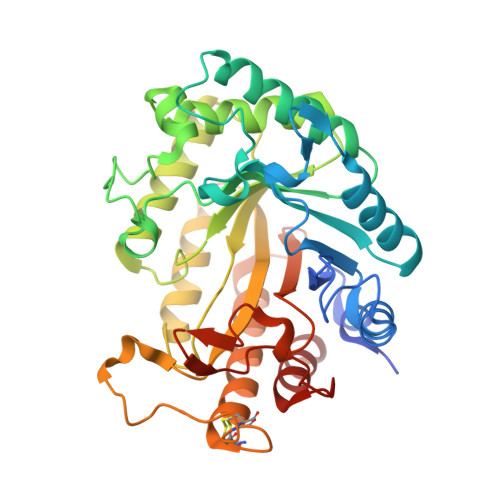The Use of Forced Protein Evolution to Investigate and Improve Stability of Family 10 Xylanases: The Production of Ca2+-Independent Stable Xylanases
Andrews, S., Taylor, E.J., Pell, G.N., Vincent, F., Ducros, V.M.A., Davies, G.J., Lakey, J.H., Gilbert, H.J.(2004) J Biol Chem 279: 54369
- PubMed: 15452124
- DOI: https://doi.org/10.1074/jbc.M409044200
- Primary Citation of Related Structures:
1W2P, 1W2V, 1W32, 1W3H - PubMed Abstract:
Metal ions such as calcium often play a key role in protein thermostability. The inclusion of metal ions in industrial processes is, however, problematic. Thus, the evolution of enzymes that display enhanced stability, which is not reliant on divalent metals, is an important biotechnological goal. Here we have used forced protein evolution to interrogate whether the stabilizing effect of calcium in an industrially relevant enzyme can be replaced with amino acid substitutions. Our study has focused on the GH10 xylanase CjXyn10A from Cellvibrio japonicus, which contains an extended calcium binding loop that confers proteinase resistance and thermostability. Three rounds of error-prone PCR and selection identified a treble mutant, D262N/A80T/R347C, which in the absence of calcium is more thermostable than wild type CjXyn10A bound to the divalent metal. D262N influences the properties of the calcium binding site, A80T fills a cavity in the enzyme, increasing the number of hydrogen bonds and van der Waals interactions, and the R347C mutation introduces a disulfide bond that decreases the free energy of the unfolded enzyme. A derivative of CjXyn10A (CfCjXyn10A) in which the calcium binding loop has been replaced with a much shorter loop from Cellulomonas fimi CfXyn10A was also subjected to forced protein evolution to select for thermostablizing mutations. Two amino acid substitutions within the introduced loop and the A80T mutation increased the thermostability of the enzyme. This study demonstrates how forced protein evolution can be used to introduce enhanced stability into industrially relevant enzymes while removing calcium as a major stability determinant.
Organizational Affiliation:
Structural Biology Laboratory, Department of Chemistry, University of York, Heslington, York YO10 5YW, UK.
















